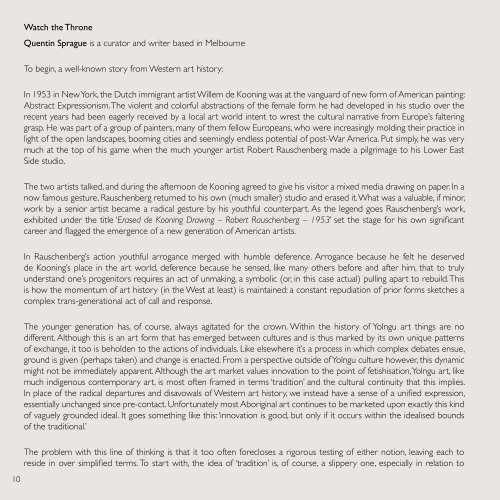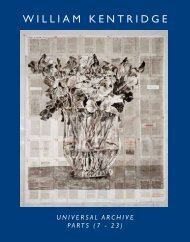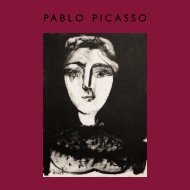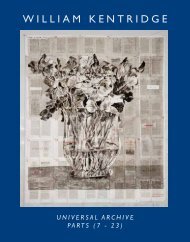Download PDF Catalogue - Annandale Galleries
Download PDF Catalogue - Annandale Galleries
Download PDF Catalogue - Annandale Galleries
You also want an ePaper? Increase the reach of your titles
YUMPU automatically turns print PDFs into web optimized ePapers that Google loves.
Watch the Throne<br />
Quentin Sprague is a curator and writer based in Melbourne<br />
To begin, a well-known story from Western art history:<br />
In 1953 in New York, the Dutch immigrant artist Willem de Kooning was at the vanguard of new form of American painting:<br />
Abstract Expressionism. The violent and colorful abstractions of the female form he had developed in his studio over the<br />
recent years had been eagerly received by a local art world intent to wrest the cultural narrative from Europe’s faltering<br />
grasp. He was part of a group of painters, many of them fellow Europeans, who were increasingly molding their practice in<br />
light of the open landscapes, booming cities and seemingly endless potential of post-War America. Put simply, he was very<br />
much at the top of his game when the much younger artist Robert Rauschenberg made a pilgrimage to his Lower East<br />
Side studio.<br />
The two artists talked, and during the afternoon de Kooning agreed to give his visitor a mixed media drawing on paper. In a<br />
now famous gesture, Rauschenberg returned to his own (much smaller) studio and erased it. What was a valuable, if minor,<br />
work by a senior artist became a radical gesture by his youthful counterpart. As the legend goes Rauschenberg’s work,<br />
exhibited under the title ‘Erased de Kooning Drawing – Robert Rauschenberg – 1953’ set the stage for his own significant<br />
career and flagged the emergence of a new generation of American artists.<br />
In Rauschenberg’s action youthful arrogance merged with humble deference. Arrogance because he felt he deserved<br />
de Kooning’s place in the art world, deference because he sensed, like many others before and after him, that to truly<br />
understand one’s progenitors requires an act of unmaking, a symbolic (or, in this case actual) pulling apart to rebuild. This<br />
is how the momentum of art history (in the West at least) is maintained: a constant repudiation of prior forms sketches a<br />
complex trans-generational act of call and response.<br />
The younger generation has, of course, always agitated for the crown. Within the history of Yolngu art things are no<br />
different. Although this is an art form that has emerged between cultures and is thus marked by its own unique patterns<br />
of exchange, it too is beholden to the actions of individuals. Like elsewhere it’s a process in which complex debates ensue,<br />
ground is given (perhaps taken) and change is enacted. From a perspective outside of Yolngu culture however, this dynamic<br />
might not be immediately apparent. Although the art market values innovation to the point of fetishisation, Yolngu art, like<br />
much indigenous contemporary art, is most often framed in terms ‘tradition’ and the cultural continuity that this implies.<br />
In place of the radical departures and disavowals of Western art history, we instead have a sense of a unified expression,<br />
essentially unchanged since pre-contact. Unfortunately most Aboriginal art continues to be marketed upon exactly this kind<br />
of vaguely grounded ideal. It goes something like this: ‘innovation is good, but only if it occurs within the idealised bounds<br />
of the traditional.’<br />
The problem with this line of thinking is that it too often forecloses a rigorous testing of either notion, leaving each to<br />
reside in over simplified terms. To start with, the idea of ‘tradition’ is, of course, a slippery one, especially in relation to<br />
10









